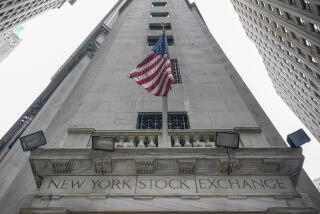Lenders Are Cautioned by Greenspan : Banking: Fed chief notes that the industry is stronger than it has been in decades, but he issues a reminder of past mistakes.
- Share via
Federal Reserve Chairman Alan Greenspan voiced concern Thursday that the nation’s banks may be relaxing loan standards too much in order to win new business, but analysts and lenders said they see little threat of a 1980s-style banking crisis.
While noting that American banks are the strongest they’ve been in decades, Greenspan told members of the Senate Banking Committee that some lenders are beginning to loosen their credit requirements and will have to be careful if they want to avoid another industry debacle.
“In recent months, I have begun to receive reports from examiners and from surveys that banks are competing more aggressively for loans, and they are relaxing their credit standards,” the Fed chairman told a hearing on the health of the banking industry.
“It is too early to know if banks are easing excessively, but our examiners are sensitive to such concerns,” he added.
Whatever the danger nationally, banking analysts said there is little or no problem in California, where some borrowers have complained that just the opposite situation prevails.
“The big California banks are in very good shape, and they have been especially prudent about the loans they make because they’ve been worried about the (state’s) recession,” said Harry Gage of Gage & Co., a Pasadena-based bank-consulting firm.
“If our economy here slowly gets better, our banks are only going to get stronger” because fewer loans will go sour, Gage said.
Bank failures exceeded 200 a year in the late 1980s and early ‘90s after energy, agricultural and real estate loans went sour. The fund that insures bank deposits dipped into the red in 1992, raising fears of a thrift-style taxpayer bailout.
Banks subsequently tightened credit standards, triggering the “credit crunch” that strained businesses and consumers trying to get loans and contributed to the recession.
Indeed, some experts complain that California bankers’ insistence on strict underwriting standards for both consumers and businesses is holding back the state’s fledgling recovery.
Nonetheless, many banks in the southern part of the state say most types of lending activity are on the upswing.
“We’ve seen steady increases in loans to home builders, and manufacturers and retailers are also borrowing more money to expand,” said Doug Stewart, executive vice president at Los Angeles-based Sanwa Bank California. “But I think every banker is being prudent about who we loan money to--we want a repeat of the banking crisis even less than Greenspan does.”
Greenspan made clear that for now, the Fed sees no “major problems looming” for the banking industry.
As he spoke, federal bank regulators were reporting an 8.7% jump in banking profits in the second quarter to $11.2 billion, the second-highest quarterly total ever. Earnings in the first half of 1994 hit $22.3 billion, the most ever for any six-month period.
“The banking system is stronger now than it has been in many years, and it seems well prepared to meet the nation’s credit needs,” the Fed chief said.
But Greenspan warned bankers that they cannot become complacent and allow reserves to fall so much that they might be inadequate to meet potential trouble down the road.
He noted that some banks have sharply curtailed or even eliminated the amount they set aside for loans likely to go sour. Many banks took no loan-loss provisions in the first half of the year.
“I am not questioning those decisions at this time,” Greenspan said. “Nonetheless, I would urge the industry to guard against letting reserves decline too far.”
Meanwhile, Greenspan and other regulators also warned that the savings and loan industry could again get in hot water if, as expected, S&Ls; soon end up paying higher fees for deposit insurance than banks. More S&Ls; could fail as they lose out competitively to banks, straining the insurance fund that backs S&L; deposits.
The premiums now are about the same, about 23 cents for every $100 of insured deposits.
But banks could be paying much less next year, assuming the Bank Insurance Fund is replenished to mandated levels ahead of the thrift fund, as expected.
Jonathan Fiechter, the top thrift regulator, said “there is no current crisis.” But he warned that the higher the premiums thrifts must pay for deposit insurance, the more failed S&Ls; the thrift insurance fund may have to handle.
*
Times wire services contributed to this report.
More to Read
Inside the business of entertainment
The Wide Shot brings you news, analysis and insights on everything from streaming wars to production — and what it all means for the future.
You may occasionally receive promotional content from the Los Angeles Times.










